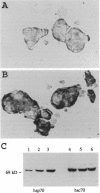Abstract
When cultures of pancreatic islet cells are exposed to the nitric oxide donor sodium nitroprusside, to enzymatically generated reactive oxygen intermediates or to streptozotocin cell lysis occurs after 4-12 h. We report here that a heat shock at 43 degrees C for 90 min reduces cell lysis from nitric oxide (0.45 mM sodium nitroprusside) by 70%, from reactive oxygen intermediates (12 mU xanthine oxidase and 0.05 mM hypoxanthine) by 80% and from streptozotocin (1.5 mM) by 90%. Heat shock induced resistance was observed immediately after termination of the 90 min culture at 43 degrees C and correlated with enhanced expression of hsp70. The occurrence of DNA strand breaks, a major early consequence of nitric oxide, reactive oxygen intermediates, or streptozotocin action, was not suppressed by heat shock treatment. However, the depletion of NAD+, the major cause of radical induced islet cell death, was suppressed after heat shock (P < 0.01). We conclude that pancreatic islet cells can rapidly activate defence mechanisms against nitric oxide, reactive oxygen intermediates and streptozotocin by culture at 43 degrees C. Islet cell survival is due to the prevention of lethal NAD+ depletion during DNA repair, probably by slowing down poly(ADP-ribose)polymerase activation.
Full text
PDF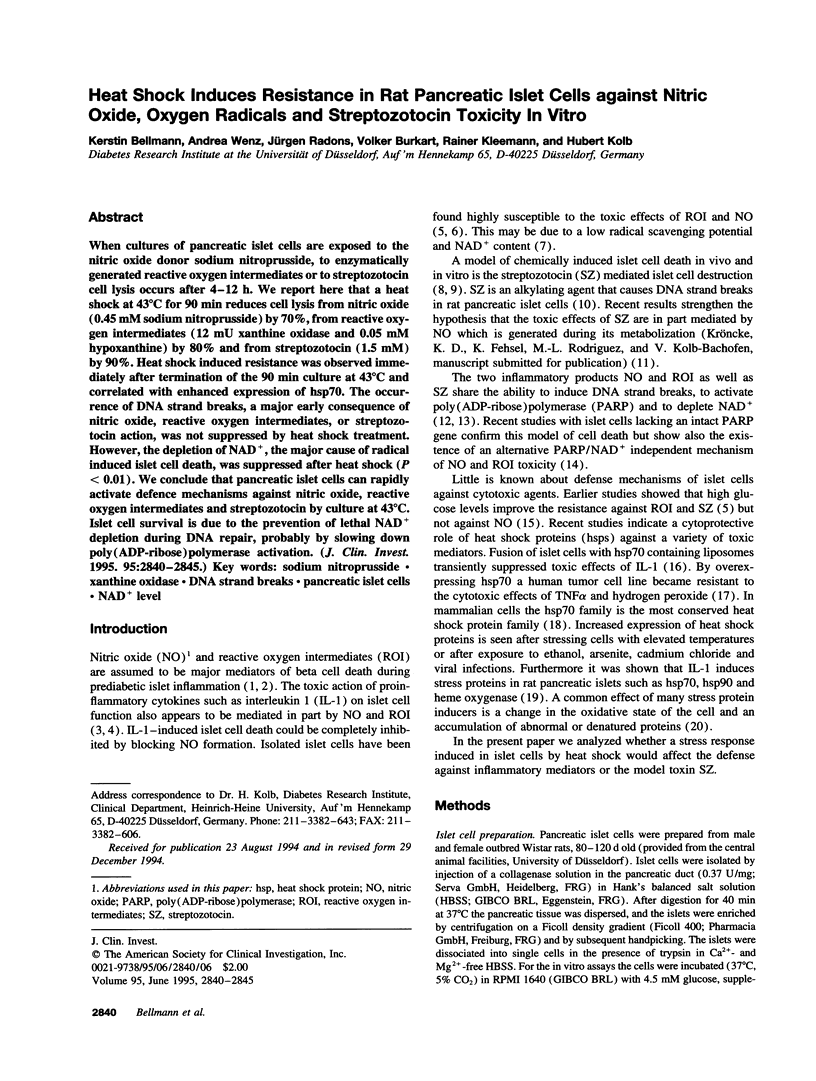
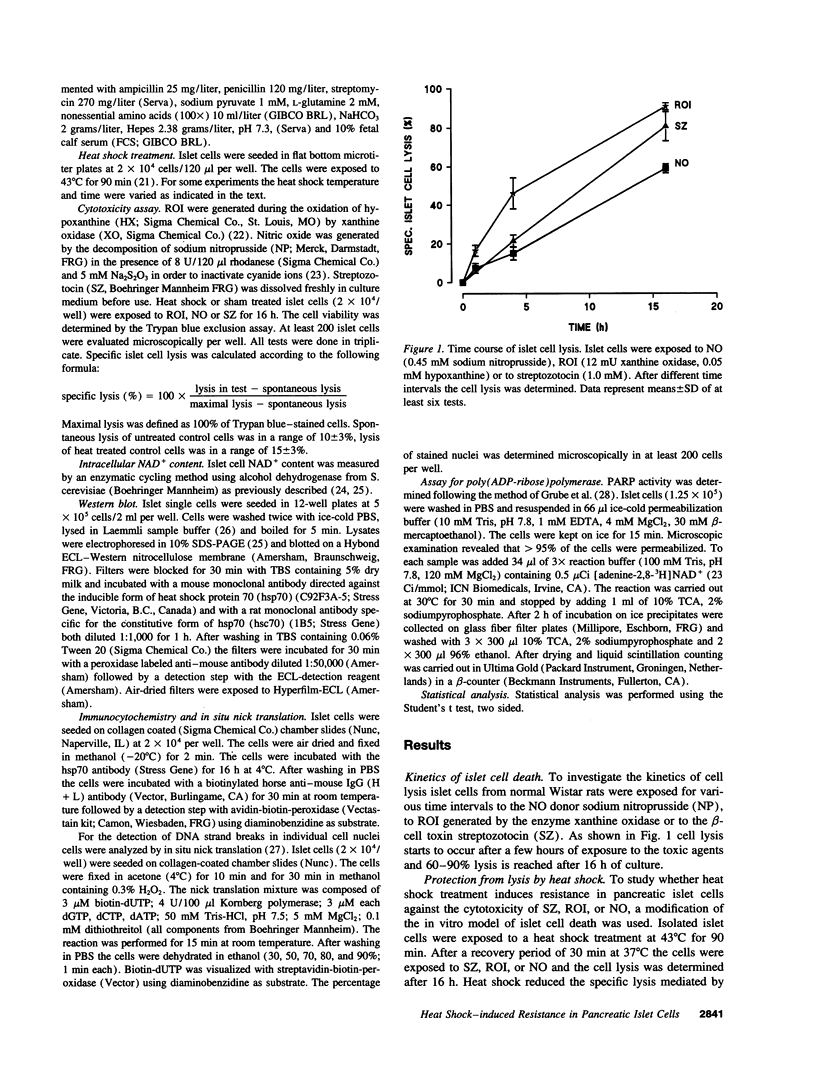
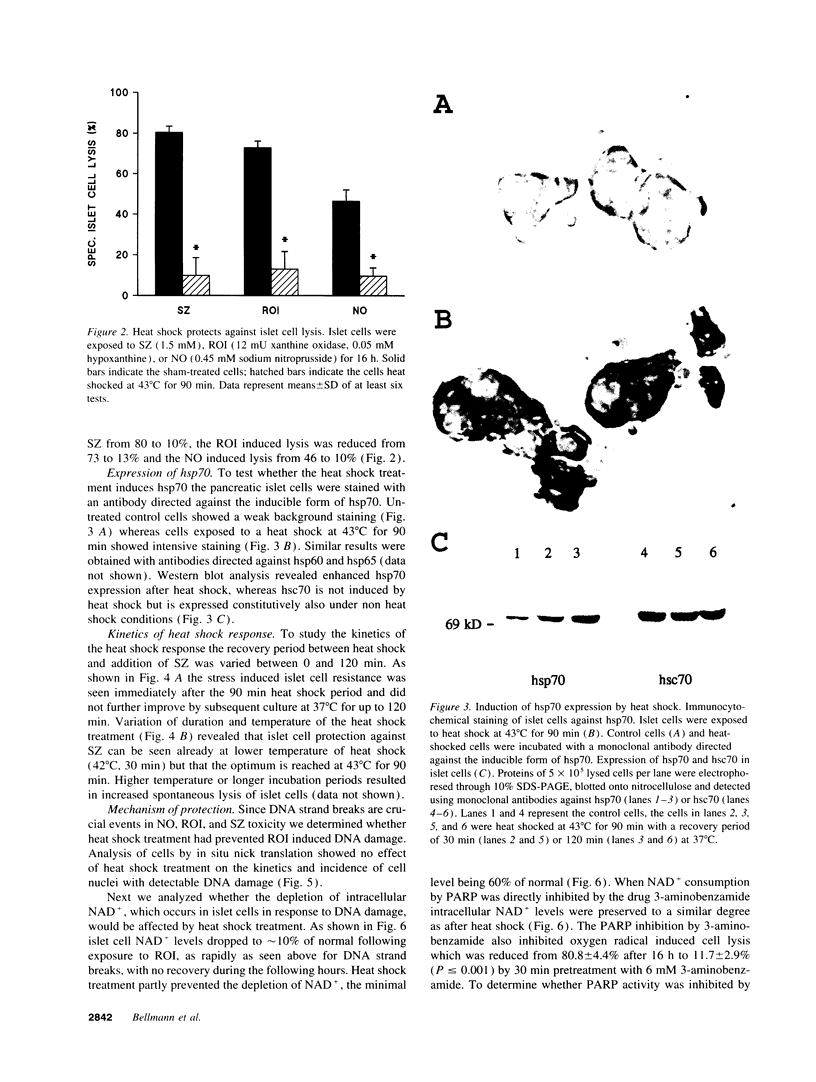
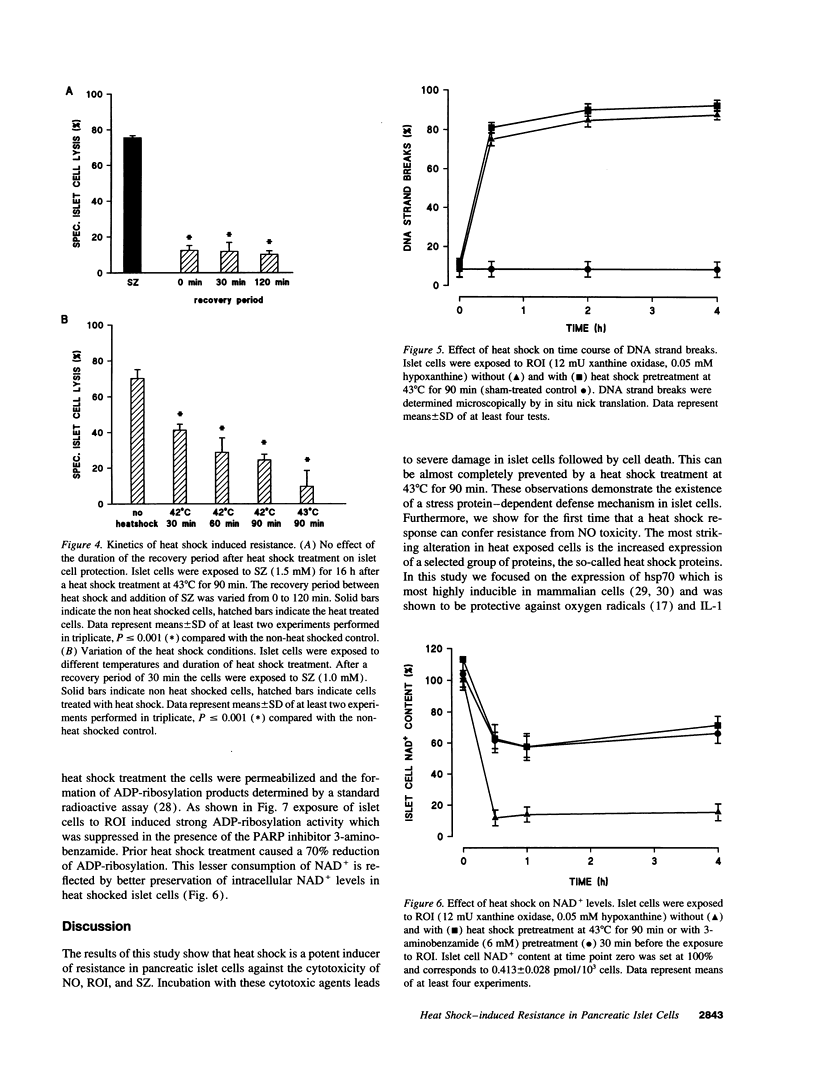
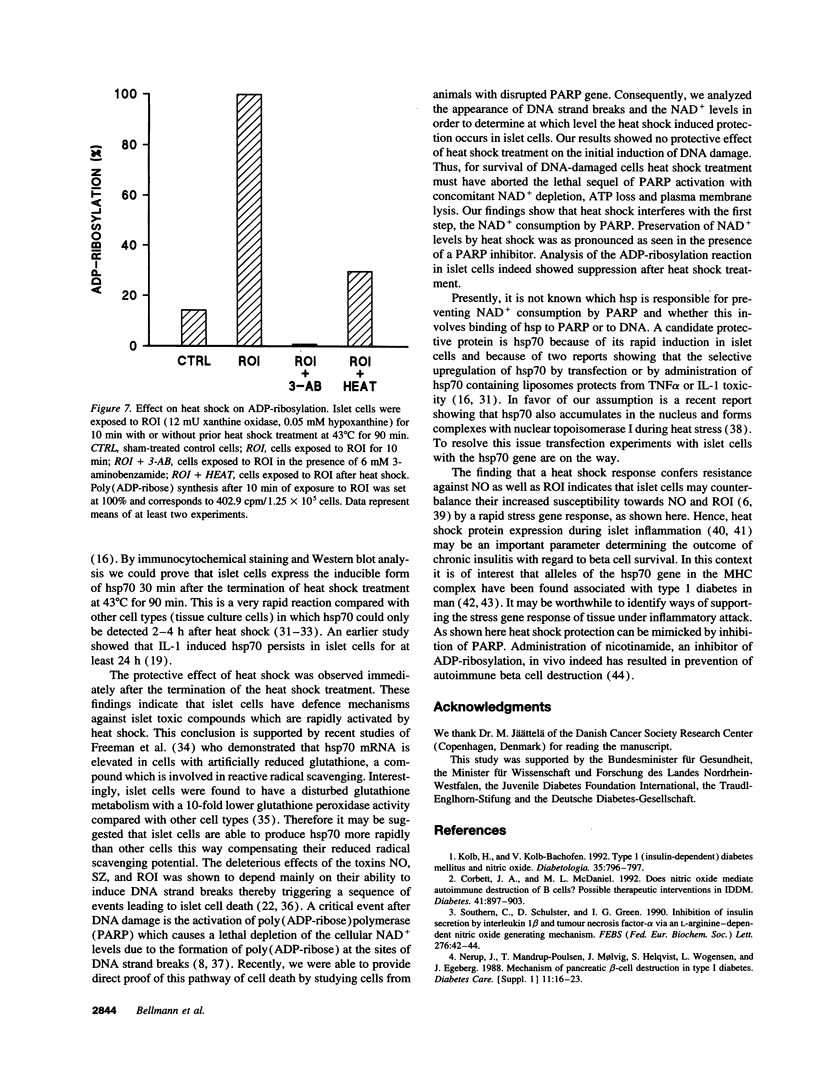
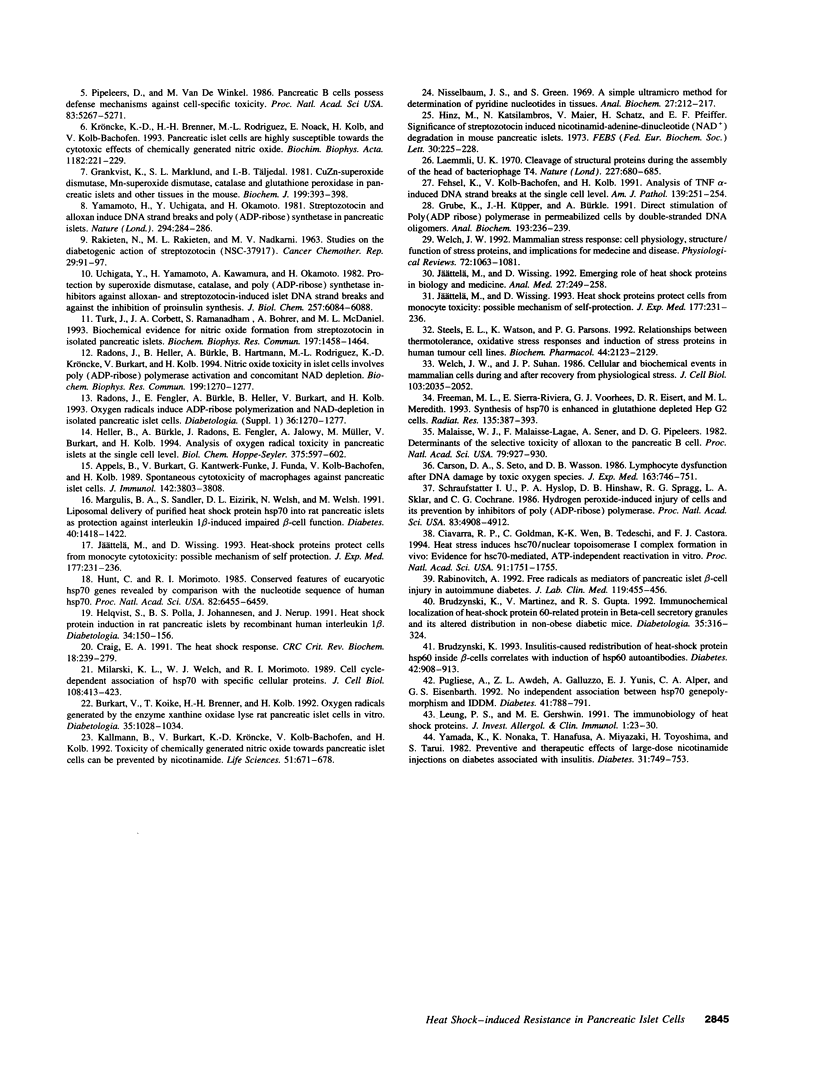
Images in this article
Selected References
These references are in PubMed. This may not be the complete list of references from this article.
- Appels B., Burkart V., Kantwerk-Funke G., Funda J., Kolb-Bachofen V., Kolb H. Spontaneous cytotoxicity of macrophages against pancreatic islet cells. J Immunol. 1989 Jun 1;142(11):3803–3808. [PubMed] [Google Scholar]
- Brudzynski K. Insulitis-caused redistribution of heat-shock protein HSP60 inside beta-cells correlates with induction of HSP60 autoantibodies. Diabetes. 1993 Jun;42(6):908–913. doi: 10.2337/diab.42.6.908. [DOI] [PubMed] [Google Scholar]
- Brudzynski K., Martinez V., Gupta R. S. Immunocytochemical localization of heat-shock protein 60-related protein in beta-cell secretory granules and its altered distribution in non-obese diabetic mice. Diabetologia. 1992 Apr;35(4):316–324. doi: 10.1007/BF00401198. [DOI] [PubMed] [Google Scholar]
- Burkart V., Koike T., Brenner H. H., Kolb H. Oxygen radicals generated by the enzyme xanthine oxidase lyse rat pancreatic islet cells in vitro. Diabetologia. 1992 Nov;35(11):1028–1034. doi: 10.1007/BF02221677. [DOI] [PubMed] [Google Scholar]
- Carson D. A., Seto S., Wasson D. B. Lymphocyte dysfunction after DNA damage by toxic oxygen species. A model of immunodeficiency. J Exp Med. 1986 Mar 1;163(3):746–751. doi: 10.1084/jem.163.3.746. [DOI] [PMC free article] [PubMed] [Google Scholar]
- Ciavarra R. P., Goldman C., Wen K. K., Tedeschi B., Castora F. J. Heat stress induces hsc70/nuclear topoisomerase I complex formation in vivo: evidence for hsc70-mediated, ATP-independent reactivation in vitro. Proc Natl Acad Sci U S A. 1994 Mar 1;91(5):1751–1755. doi: 10.1073/pnas.91.5.1751. [DOI] [PMC free article] [PubMed] [Google Scholar]
- Corbett J. A., McDaniel M. L. Does nitric oxide mediate autoimmune destruction of beta-cells? Possible therapeutic interventions in IDDM. Diabetes. 1992 Aug;41(8):897–903. doi: 10.2337/diab.41.8.897. [DOI] [PubMed] [Google Scholar]
- Craig E. A. The heat shock response. CRC Crit Rev Biochem. 1985;18(3):239–280. doi: 10.3109/10409238509085135. [DOI] [PubMed] [Google Scholar]
- Fehsel K., Kolb-Bachofen V., Kolb H. Analysis of TNF alpha-induced DNA strand breaks at the single cell level. Am J Pathol. 1991 Aug;139(2):251–254. [PMC free article] [PubMed] [Google Scholar]
- Freeman M. L., Sierra-Rivera E., Voorhees G. J., Eisert D. R., Meredith M. J. Synthesis of hsp-70 is enhanced in glutathione-depleted Hep G2 cells. Radiat Res. 1993 Sep;135(3):387–393. doi: 10.2307/3578879. [DOI] [PubMed] [Google Scholar]
- Grankvist K., Marklund S. L., Täljedal I. B. CuZn-superoxide dismutase, Mn-superoxide dismutase, catalase and glutathione peroxidase in pancreatic islets and other tissues in the mouse. Biochem J. 1981 Nov 1;199(2):393–398. doi: 10.1042/bj1990393. [DOI] [PMC free article] [PubMed] [Google Scholar]
- Grube K., Küpper J. H., Bürkle A. Direct stimulation of poly(ADP ribose) polymerase in permeabilized cells by double-stranded DNA oligomers. Anal Biochem. 1991 Mar 2;193(2):236–239. doi: 10.1016/0003-2697(91)90015-l. [DOI] [PubMed] [Google Scholar]
- Heller B., Bürkle A., Radons J., Fengler E., Jalowy A., Müller M., Burkart V., Kolb H. Analysis of oxygen radical toxicity in pancreatic islets at the single cell level. Biol Chem Hoppe Seyler. 1994 Sep;375(9):597–602. doi: 10.1515/bchm3.1994.375.9.597. [DOI] [PubMed] [Google Scholar]
- Helqvist S., Polla B. S., Johannesen J., Nerup J. Heat shock protein induction in rat pancreatic islets by recombinant human interleukin 1 beta. Diabetologia. 1991 Mar;34(3):150–156. doi: 10.1007/BF00418268. [DOI] [PubMed] [Google Scholar]
- Hinz M., Katsilambros N., Maier V., Schatz H., Pfeiffer E. F. Significance of streptozotocin induced nicotinamide-adenine-dinucleotide (NAD) degradation in mouse pancreatic islets. FEBS Lett. 1973 Mar 1;30(2):225–228. doi: 10.1016/0014-5793(73)80656-8. [DOI] [PubMed] [Google Scholar]
- Hunt C., Morimoto R. I. Conserved features of eukaryotic hsp70 genes revealed by comparison with the nucleotide sequence of human hsp70. Proc Natl Acad Sci U S A. 1985 Oct;82(19):6455–6459. doi: 10.1073/pnas.82.19.6455. [DOI] [PMC free article] [PubMed] [Google Scholar]
- Jättelä M., Wissing D. Emerging role of heat shock proteins in biology and medicine. Ann Med. 1992 Aug;24(4):249–258. doi: 10.3109/07853899209149952. [DOI] [PubMed] [Google Scholar]
- Jättelä M., Wissing D. Heat-shock proteins protect cells from monocyte cytotoxicity: possible mechanism of self-protection. J Exp Med. 1993 Jan 1;177(1):231–236. doi: 10.1084/jem.177.1.231. [DOI] [PMC free article] [PubMed] [Google Scholar]
- Jättelä M., Wissing D. Heat-shock proteins protect cells from monocyte cytotoxicity: possible mechanism of self-protection. J Exp Med. 1993 Jan 1;177(1):231–236. doi: 10.1084/jem.177.1.231. [DOI] [PMC free article] [PubMed] [Google Scholar]
- Kallmann B., Burkart V., Kröncke K. D., Kolb-Bachofen V., Kolb H. Toxicity of chemically generated nitric oxide towards pancreatic islet cells can be prevented by nicotinamide. Life Sci. 1992;51(9):671–678. doi: 10.1016/0024-3205(92)90240-p. [DOI] [PubMed] [Google Scholar]
- Kolb H., Kolb-Bachofen V. Type 1 (insulin-dependent) diabetes mellitus and nitric oxide. Diabetologia. 1992 Aug;35(8):796–797. doi: 10.1007/BF00429103. [DOI] [PubMed] [Google Scholar]
- Kröncke K. D., Brenner H. H., Rodriguez M. L., Etzkorn K., Noack E. A., Kolb H., Kolb-Bachofen V. Pancreatic islet cells are highly susceptible towards the cytotoxic effects of chemically generated nitric oxide. Biochim Biophys Acta. 1993 Sep 8;1182(2):221–229. doi: 10.1016/0925-4439(93)90144-p. [DOI] [PubMed] [Google Scholar]
- Laemmli U. K. Cleavage of structural proteins during the assembly of the head of bacteriophage T4. Nature. 1970 Aug 15;227(5259):680–685. doi: 10.1038/227680a0. [DOI] [PubMed] [Google Scholar]
- Leung P. S., Gershwin M. E. The immunobiology of heat shock proteins. J Investig Allergol Clin Immunol. 1991 Feb;1(1):23–30. [PubMed] [Google Scholar]
- Malaisse W. J., Malaisse-Lagae F., Sener A., Pipeleers D. G. Determinants of the selective toxicity of alloxan to the pancreatic B cell. Proc Natl Acad Sci U S A. 1982 Feb;79(3):927–930. doi: 10.1073/pnas.79.3.927. [DOI] [PMC free article] [PubMed] [Google Scholar]
- Margulis B. A., Sandler S., Eizirik D. L., Welsh N., Welsh M. Liposomal delivery of purified heat shock protein hsp70 into rat pancreatic islets as protection against interleukin 1 beta-induced impaired beta-cell function. Diabetes. 1991 Nov;40(11):1418–1422. doi: 10.2337/diab.40.11.1418. [DOI] [PubMed] [Google Scholar]
- Milarski K. L., Welch W. J., Morimoto R. I. Cell cycle-dependent association of HSP70 with specific cellular proteins. J Cell Biol. 1989 Feb;108(2):413–423. doi: 10.1083/jcb.108.2.413. [DOI] [PMC free article] [PubMed] [Google Scholar]
- Nerup J., Mandrup-Poulsen T., Mølvig J., Helqvist S., Wogensen L., Egeberg J. Mechanisms of pancreatic beta-cell destruction in type I diabetes. Diabetes Care. 1988 Nov-Dec;11 (Suppl 1):16–23. [PubMed] [Google Scholar]
- Nisselbaum J. S., Green S. A simple ultramicro method for determination of pyridine nucleotides in tissues. Anal Biochem. 1969 Feb;27(2):212–217. doi: 10.1016/0003-2697(69)90025-6. [DOI] [PubMed] [Google Scholar]
- Pipeleers D., Van de Winkel M. Pancreatic B cells possess defense mechanisms against cell-specific toxicity. Proc Natl Acad Sci U S A. 1986 Jul;83(14):5267–5271. doi: 10.1073/pnas.83.14.5267. [DOI] [PMC free article] [PubMed] [Google Scholar]
- Pugliese A., Awdeh Z. L., Galluzzo A., Yunis E. J., Alper C. A., Eisenbarth G. S. No independent association between HSP70 gene polymorphism and IDDM. Diabetes. 1992 Jul;41(7):788–791. doi: 10.2337/diab.41.7.788. [DOI] [PubMed] [Google Scholar]
- RAKIETEN N., RAKIETEN M. L., NADKARNI M. V. Studies on the diabetogenic action of streptozotocin (NSC-37917). Cancer Chemother Rep. 1963 May;29:91–98. [PubMed] [Google Scholar]
- Rabinovitch A. Free radicals as mediators of pancreatic islet beta-cell injury in autoimmune diabetes. J Lab Clin Med. 1992 May;119(5):455–456. [PubMed] [Google Scholar]
- Radons J., Heller B., Bürkle A., Hartmann B., Rodriguez M. L., Kröncke K. D., Burkart V., Kolb H. Nitric oxide toxicity in islet cells involves poly(ADP-ribose) polymerase activation and concomitant NAD+ depletion. Biochem Biophys Res Commun. 1994 Mar 30;199(3):1270–1277. doi: 10.1006/bbrc.1994.1368. [DOI] [PubMed] [Google Scholar]
- Schraufstatter I. U., Hyslop P. A., Hinshaw D. B., Spragg R. G., Sklar L. A., Cochrane C. G. Hydrogen peroxide-induced injury of cells and its prevention by inhibitors of poly(ADP-ribose) polymerase. Proc Natl Acad Sci U S A. 1986 Jul;83(13):4908–4912. doi: 10.1073/pnas.83.13.4908. [DOI] [PMC free article] [PubMed] [Google Scholar]
- Southern C., Schulster D., Green I. C. Inhibition of insulin secretion by interleukin-1 beta and tumour necrosis factor-alpha via an L-arginine-dependent nitric oxide generating mechanism. FEBS Lett. 1990 Dec 10;276(1-2):42–44. doi: 10.1016/0014-5793(90)80502-a. [DOI] [PubMed] [Google Scholar]
- Steels E. L., Watson K., Parsons P. G. Relationships between thermotolerance, oxidative stress responses and induction of stress proteins in human tumour cell lines. Biochem Pharmacol. 1992 Dec 1;44(11):2123–2129. doi: 10.1016/0006-2952(92)90338-j. [DOI] [PubMed] [Google Scholar]
- Turk J., Corbett J. A., Ramanadham S., Bohrer A., McDaniel M. L. Biochemical evidence for nitric oxide formation from streptozotocin in isolated pancreatic islets. Biochem Biophys Res Commun. 1993 Dec 30;197(3):1458–1464. doi: 10.1006/bbrc.1993.2641. [DOI] [PubMed] [Google Scholar]
- Uchigata Y., Yamamoto H., Kawamura A., Okamoto H. Protection by superoxide dismutase, catalase, and poly(ADP-ribose) synthetase inhibitors against alloxan- and streptozotocin-induced islet DNA strand breaks and against the inhibition of proinsulin synthesis. J Biol Chem. 1982 Jun 10;257(11):6084–6088. [PubMed] [Google Scholar]
- Welch W. J. Mammalian stress response: cell physiology, structure/function of stress proteins, and implications for medicine and disease. Physiol Rev. 1992 Oct;72(4):1063–1081. doi: 10.1152/physrev.1992.72.4.1063. [DOI] [PubMed] [Google Scholar]
- Welch W. J., Suhan J. P. Cellular and biochemical events in mammalian cells during and after recovery from physiological stress. J Cell Biol. 1986 Nov;103(5):2035–2052. doi: 10.1083/jcb.103.5.2035. [DOI] [PMC free article] [PubMed] [Google Scholar]
- Yamada K., Nonaka K., Hanafusa T., Miyazaki A., Toyoshima H., Tarui S. Preventive and therapeutic effects of large-dose nicotinamide injections on diabetes associated with insulitis. An observation in nonobese diabetic (NOD) mice. Diabetes. 1982 Sep;31(9):749–753. doi: 10.2337/diab.31.9.749. [DOI] [PubMed] [Google Scholar]
- Yamamoto H., Uchigata Y., Okamoto H. Streptozotocin and alloxan induce DNA strand breaks and poly(ADP-ribose) synthetase in pancreatic islets. Nature. 1981 Nov 19;294(5838):284–286. doi: 10.1038/294284a0. [DOI] [PubMed] [Google Scholar]



